

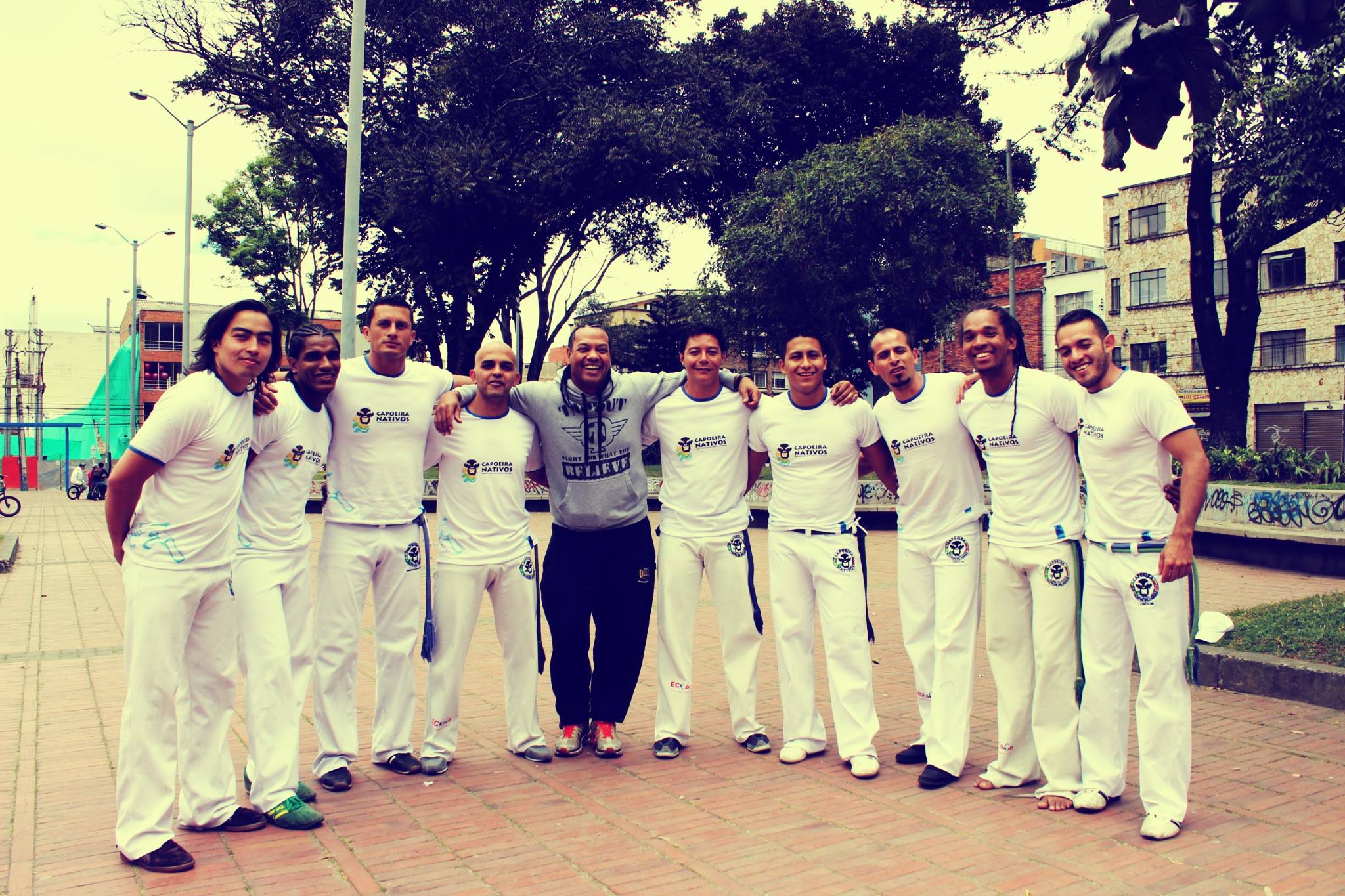

Joelson Borges de Oliveira (Mestre Aranha) was born in Tumiritinga (Minas Gerais - Brazil), in the bosom of a traditional and humble Brazilian family. From an early age he knew about capoeira and from the start dedicated his life to developing this discipline. As a result of this, along with his thirst for knowledge and his constant desire to travel, he got to know many different parts of the world.
"During his long journey and with his martial style of capoeira, in keeping with his personality, he soon built a reputation and became widely known in all the important capoeira locations"
He started in his home town under the tuition of his first teacher Mestre Acuático, his trainer during his career as a capoeirista. While today, the idea of having a master is synonymous with attending an academy, in those days it wasn’t the case, 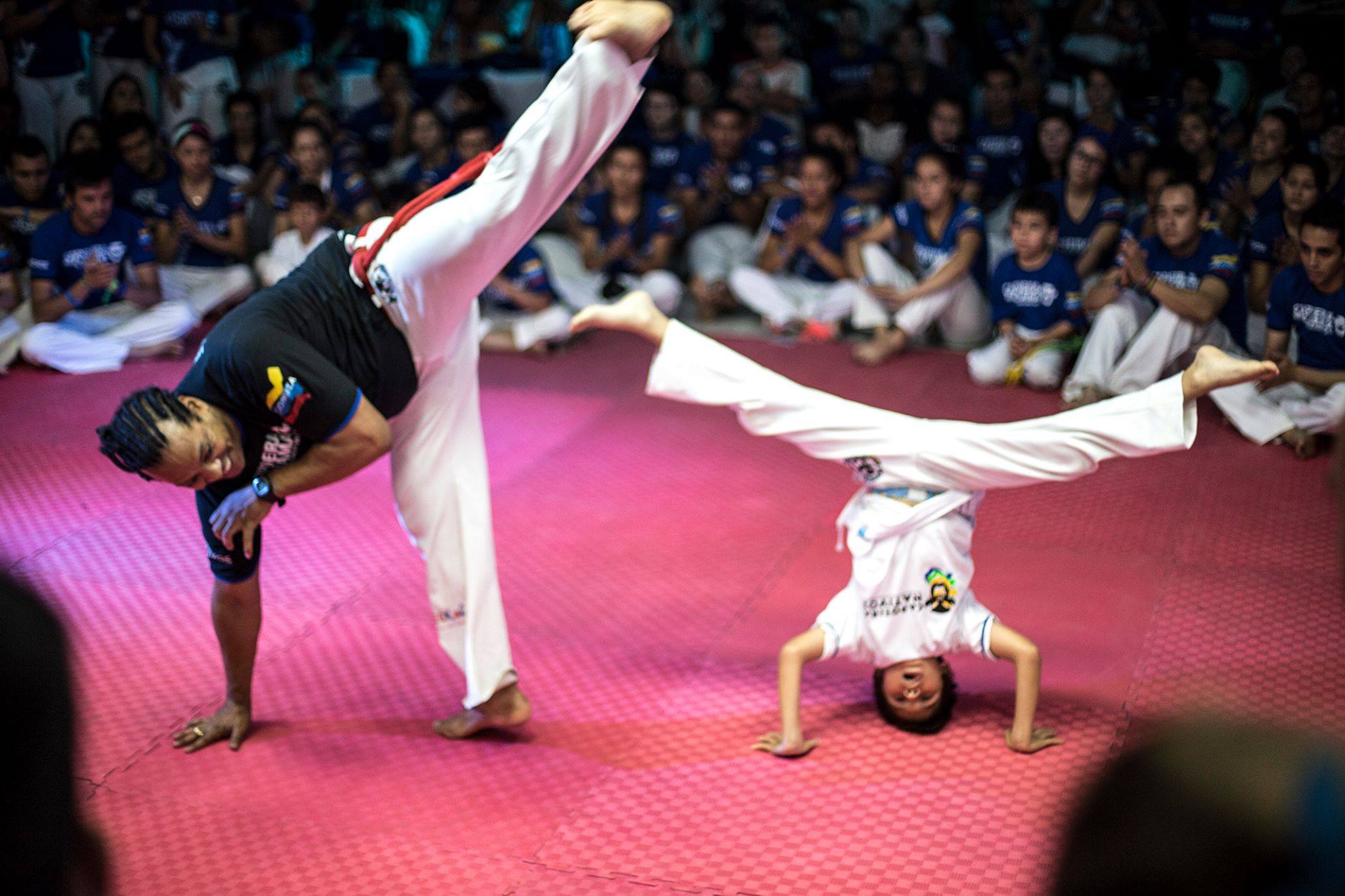 when neither the styles nor the lines of development had bCeen formulated; capoeira centred at that time around what we call capoeragem or ‘capoeira of the road’. He was no stranger to this evolution of capoeira, typified by constant journeying around every part of Brazil where the berimbau could be heard. His eager pursuit of liberty and the search for his destiny led him to take the decision to set off towards North America at 23 years of age, with the unique distinction of doing this on foot. During his long journey and with his martial style of capoeira, in keeping with his personality, he soon built a reputation and became widely known in all the important capoeira locations: Salvador Bahía, Belo Horizonte, Sao Paulo, Rio de Janeiro, Manaos, Venezuela, before finally arriving in Colombia, the place that captured him and where he dedicated 18 years to developing the discipline that is his profession.
when neither the styles nor the lines of development had bCeen formulated; capoeira centred at that time around what we call capoeragem or ‘capoeira of the road’. He was no stranger to this evolution of capoeira, typified by constant journeying around every part of Brazil where the berimbau could be heard. His eager pursuit of liberty and the search for his destiny led him to take the decision to set off towards North America at 23 years of age, with the unique distinction of doing this on foot. During his long journey and with his martial style of capoeira, in keeping with his personality, he soon built a reputation and became widely known in all the important capoeira locations: Salvador Bahía, Belo Horizonte, Sao Paulo, Rio de Janeiro, Manaos, Venezuela, before finally arriving in Colombia, the place that captured him and where he dedicated 18 years to developing the discipline that is his profession.
He gave his first Capoeira classes in Bogotá in the discotheque Saint Amour, later transferring to the gym The Muscle Factory while also promoting the sport in the National Park and the Simón Bolívar Park.
In 1997 he founded Colombia’s first Capoeira Academy in Bogotá, Colombia. During the subsequent years he continued developing the group of which he was founder under the name Nativos de Minas, opening capoeira schools in various parts of Colombia.
Today, Mestre Aranha lives in London, Great Britain, where he runs a successful Capoeira Academy.
Among Mestre Aranha’s accolades are:
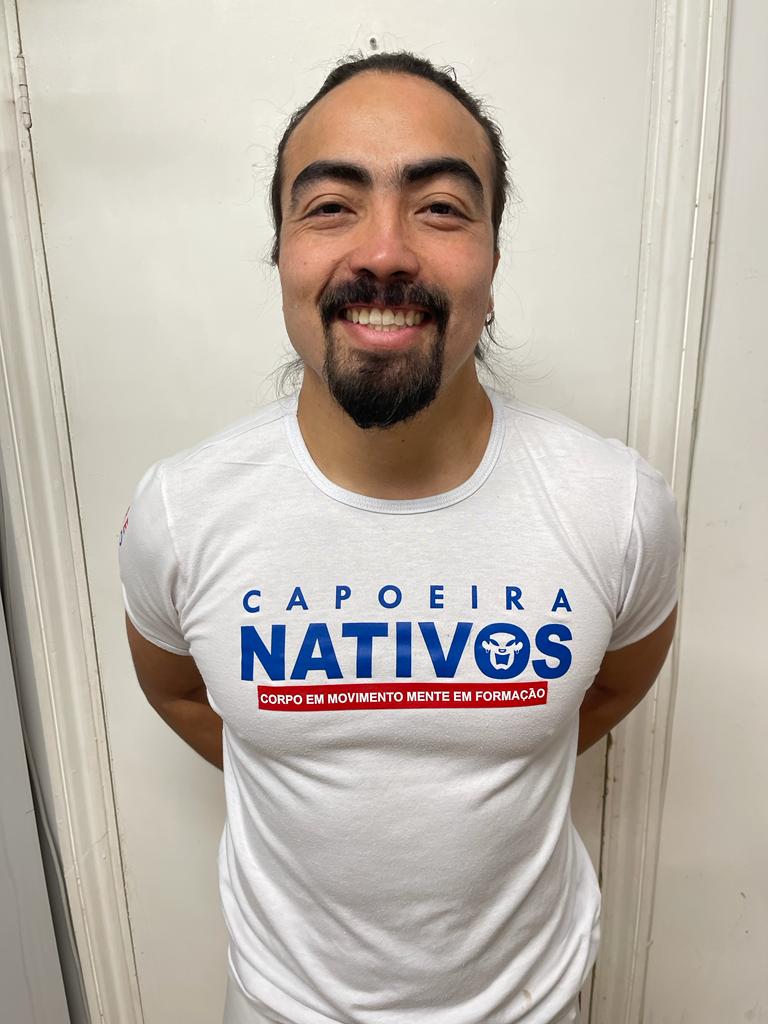
Capoeira Nativos in london is led by Samir nunez with over 20 years of experience practicing and teaching Capoeira to kids and adults.
Samir nunez (professor Japao) started practicing Capoeira at the age of 10 about 21 years ago, most of that time was spent working on different projects in Colombia, Brazil and most recently the UK.
From 2011 he managed Capoeira Nativos, the biggest Capoeira school in Colombia. He directed Capoeira events, taught classes for children and adults and lead various projects for vulnerable children and young people living in high risk communities. Since relocating to london, Samir has taken a prominent role leading the now global Capoeira organization of Nativos. He now has the pleasure to start working within the community of north London.
"I have benefited a lot from learning Capoeira since i was 10 years old and from my personal experience that can generate a great impact at this age, at the age of 10 i felt like a superhero every time i practiced Capoeira, it brought me a lot of confidence and self-esteem. Capoeira taught me a lot about teamwork and the importance of being disciplined to rich your goals in life. Learning about the cultural history of Capoeira has brought me to learn new languages and travel to different countries, understand, appreciate and interact in a positive level with others cultures, allowing me to improve my social skills like public speaking and how to create professional network connections. For me Capoeira is a school of life and i want to spread the benefit of it to the kids and adults in my classes. Axé"

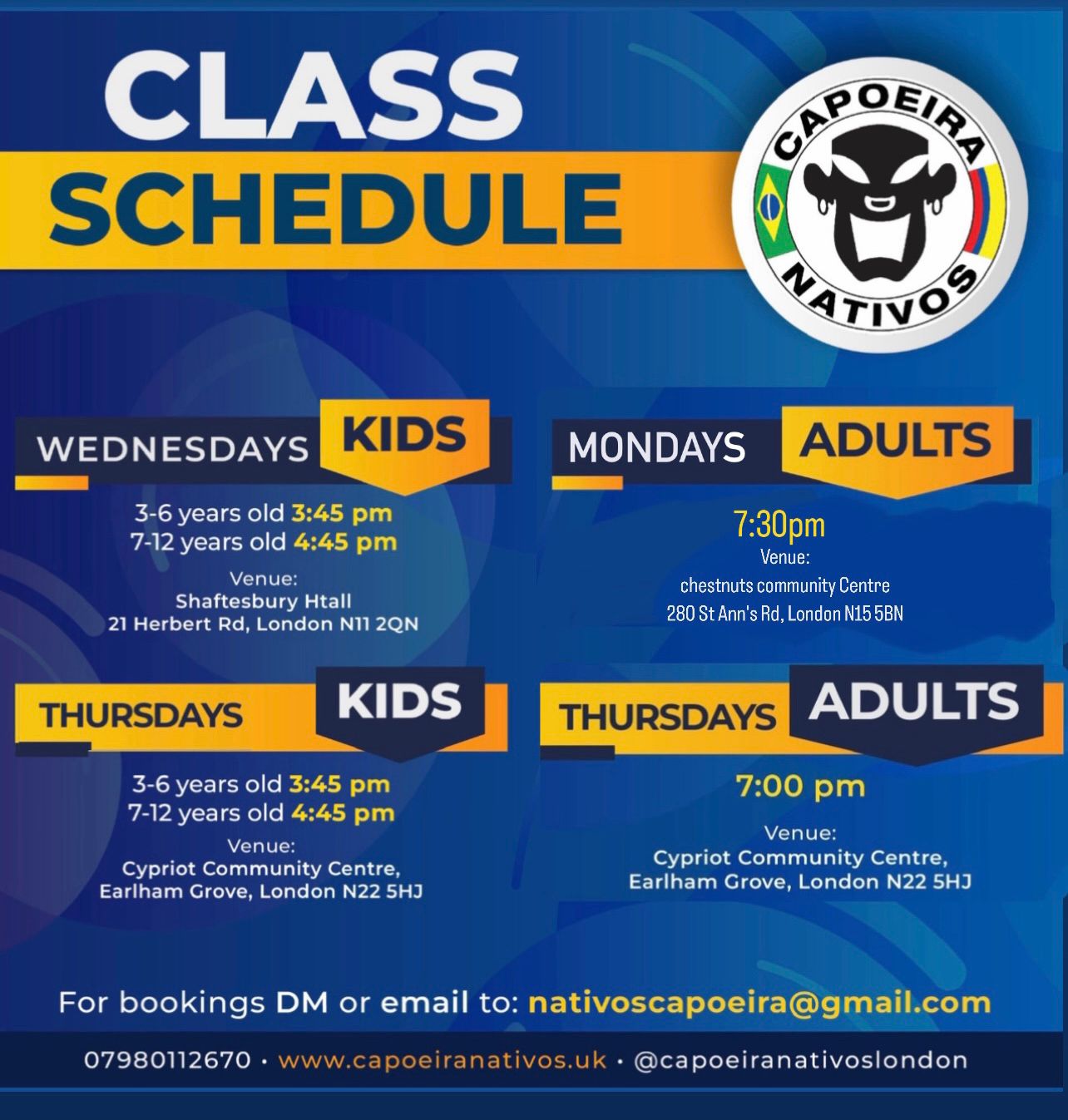
Here you will found information about capoeira and our group in North London, It's perfect for beginners who never have been in touch with capoeira, intermediates and advanced students.
Shaftesbury hall Bounds Green
21 Herbert Rd
London
N11 2QN
Wednesdays @ 3:45 - 4:45pm (3-6 yrs)
Wednesdays @ 4:45 - 5:45pm (7-12 yrs)
Cypriot Community Centre
Earlham Grove
London
N22 5HJ
Thursday @ 3:45pm to 4:45pm (3-6 yrs)
Thursday @ 4:45pm (7-12 yrs)
Chestnut community centre
280 St Ann's Rd
London
N15 5BN
Monday @ 7.30pm to 8.30pm.
Cypriot Community Centre
Earlham Grove
London
N22 5HJ
Thursday @ 6:45pm to 8.00pm.

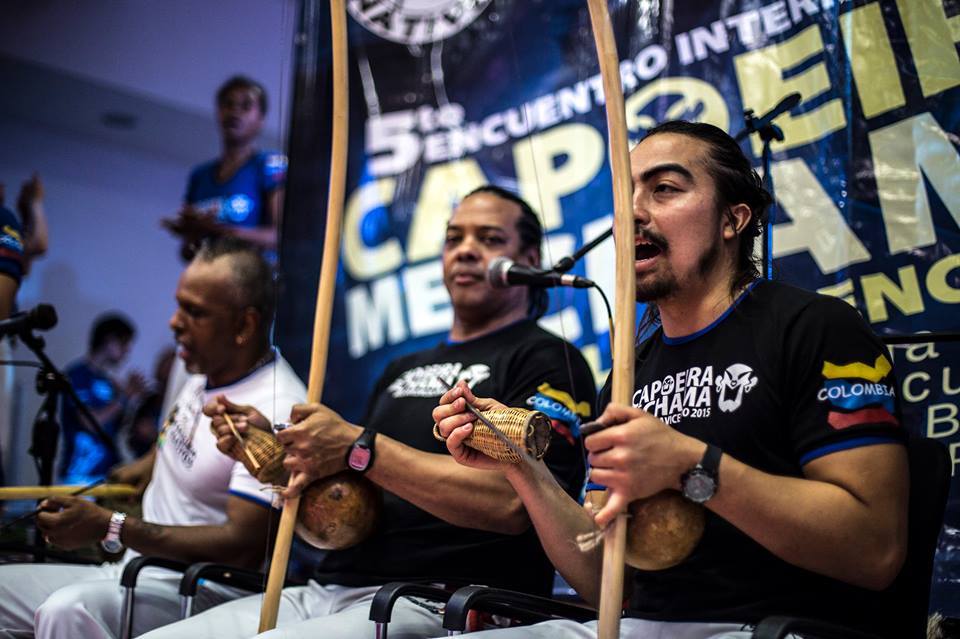
Capoeira is a form of Afro-Brazilian cultural expression encompassing various different facets and originating in Brazil. The best-known of these facets is the martial art aspect, although in fact all the others are equally important: the musical aspect and expression through bodily movements, the oral/linguistic aspect, and the traditional aspect.
Capoeira is a form of self-expression:
Os negros usavam a Capoeira para defender sua liberdade. Members of the black community use Capoeira as a means of defending their freedom.
Mestre Pastinha
The most widely accepted origin of the word capoeira comes from the Tupi words ka'a ("jungle") e pûer ("it was"), referring to the areas of low vegetation in the Brazilian interior where fugitive slaves would hide. Practitioners of the art are called capoeiristas.
On 26 November 2014 capoeira was granted a special protected status as "intangible cultural heritage" by UNESCO.
Capoeira nowadays is not only a martial art, but an active exporter of Brazilian culture all over the world. Since the 1970s, capoeira mestres began to emigrate and teach it in other countries. Present in many countries on every continent, every year capoeira attracts to Brazil thousands of foreign students and tourists. Foreign capoeiristas work hard to learn Portuguese to better understand and become part of the art. Renowned capoeira mestres often teach abroad and establish their own schools. Capoeira presentations, normally theatrical, acrobatic and with little martiality, are common sights around the world.
The martial art aspect is still present and still disguised, leading many non-practitioners to ignore its presence. Trickery is ever present and expert capoeiristas can even disguise an attack as a friendly gesture.
Symbol of the Brazilian culture, symbol of the ethnic amalgam that characterizes Brazil, symbol of resistance to the oppression, capoeira definitely changed its image and became a source of pride to Brazilian people. Capoeira is officially considered intangible cultural heritage of Brazil.
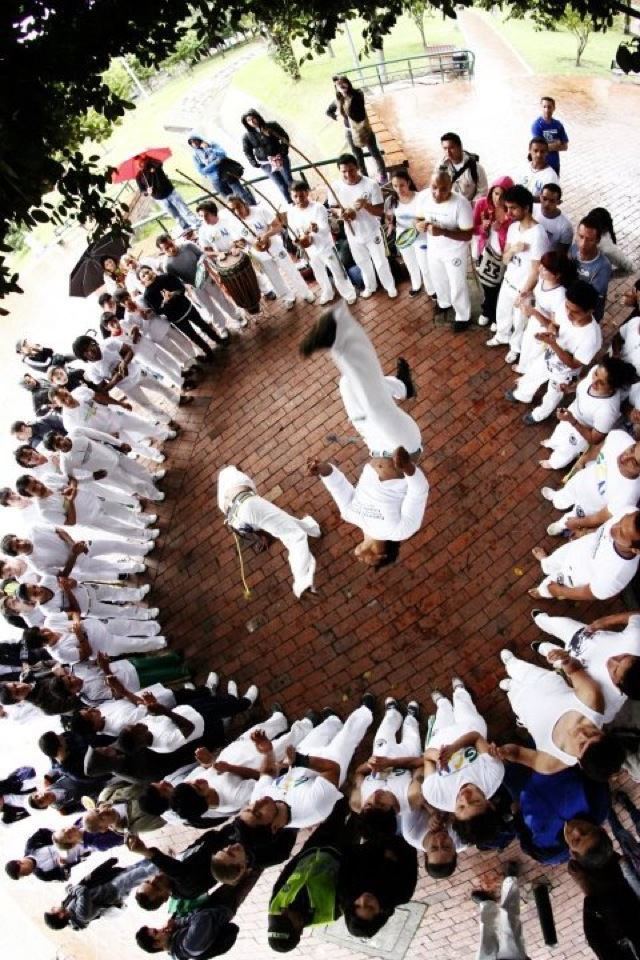
The Roda (pronounced [ˈʁodɐ]) is a circle formed by capoeiristas and capoeira musical instruments, where every participant sings the typical songs and claps their hands following the music. Two capoeiristas enter the roda and play the game according to the style required by the musical instruments rhythm. The game finishes when one of the musicians holding a berimbau determine it, when one of the capoeiristas decide to leave or call the end of the game or when another capoeirista interrupts the game to start playing, either with one of the current players or with another capoeirista.
In a roda every cultural aspect of capoeira is present, not only the martial side. Aerial acrobatics are common in a presentation roda, while not seen as often in a more serious one. Takedowns, on the other hand, are common in a serious roda but rarely seen in presentations.
"a ginga” (the basic step of capoeira) is the most important movement because it defines us as Capoeiristas. Ginga is the base for all other movements. Ginga consists of three positions; basic positions left and right and the parallel position. When we are in the basic position one of our legs is bent forward and the whole foot is on the floor, while the other leg is stretched backwards and only the toes are on the floor. At the same time it helps the ankle to push off to continue the movement flowing into the other leg.
"Ginga can give us advantages if we get used to it, and keep us active in order to quickly respond in any situation, either to attack or defend ourselves"
If we have the right leg forward then we will keep up the left arm to get a good balance and To protect the head, the arm bent over and held in front of the face.
The second position, is about to have a parallel position, then both legs stand forward and bent while your arms held up as protection for the head.
From the parallel position, we start with the other leg back and then repeat the movement to get a constant movement. The movement formers a triangle from the parallel position to the basics position.
"Os ataques" (attacks) the main capoeira attacks are made with the legs, like direct or swirling kicks, rasteiras (leg sweeps), “tesouras” or knee strikes. Elbow strikes, punches and other forms of takedowns complete the main list but they are not usuallty used. The head strike is a very important counter-attack move.
The kicks can be straight as “Martelo”, “Bencao”, “punteira” or circular movements such as the Meia-Lua de Compasso, armada, queixada etc. "A rasteira" (sweep) is a frequently movement. Many argue that it is even best attacking movement. It can be used when you are in an uncomfortable situation during the jogo, and if you use it in the right moment, you can take over jogo and get the control of the situation.
Defense is based on the principle of non-resistance, meaning avoiding an attack using evasive moves instead of blocking it. Avoids are called esquivas, which depend on the direction of the attack and intention of the defender, and can be done standing or with a hand leaning on the floor A block could be made when the esquiva is completely non-viable, you can also use your hands or legs to defend themselves from attack.
A ginga is a very important part in both defense and attack, because it means that you will not be so easily accessible, and often been in ginga mode a contra attack shows up during the jogo.
Finally, there is also "as Cabeçadas" (blow with the head), "floreios" (acrobatics), "tesouras"(nedrivningar), "cotoveladas" (elbow strikes) and so on.
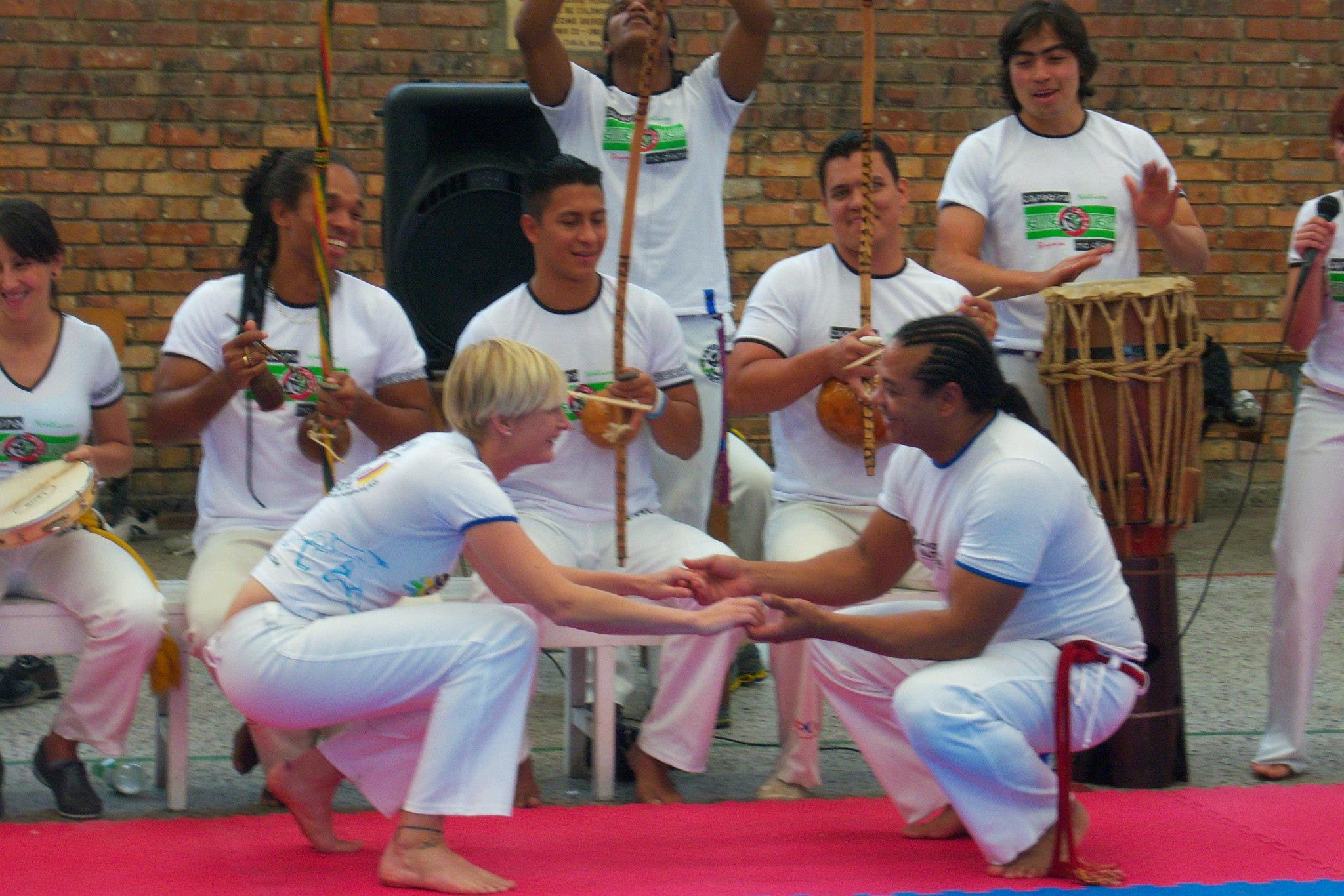
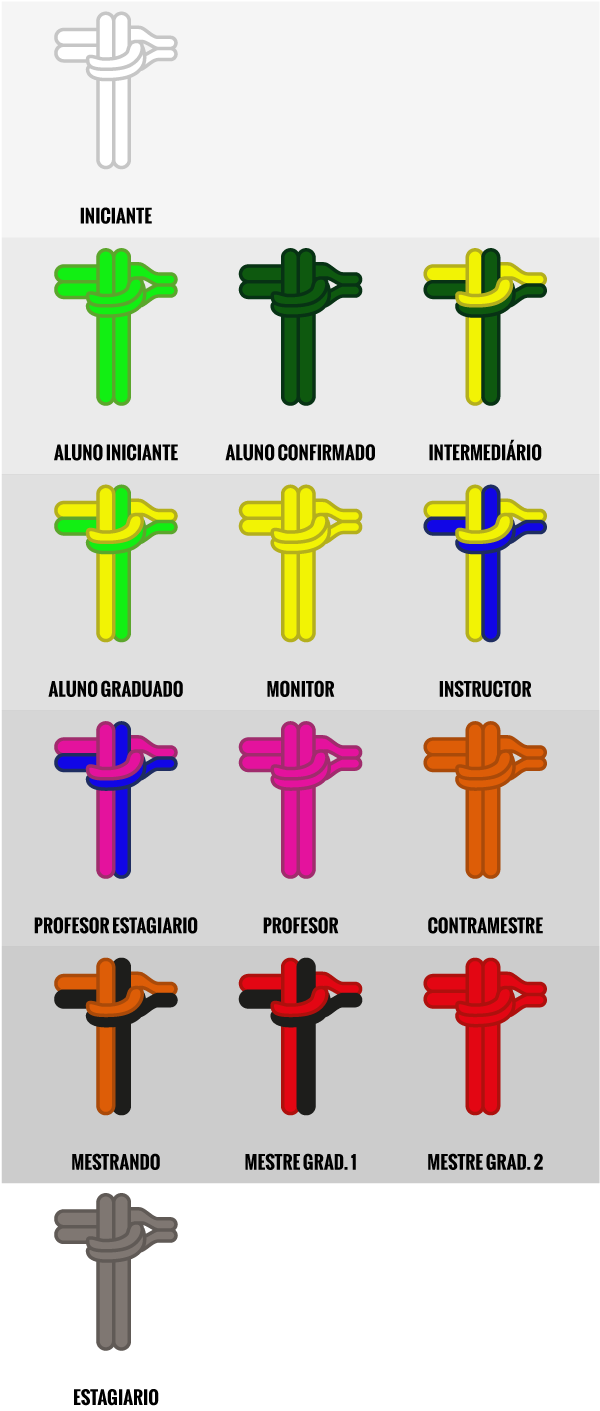
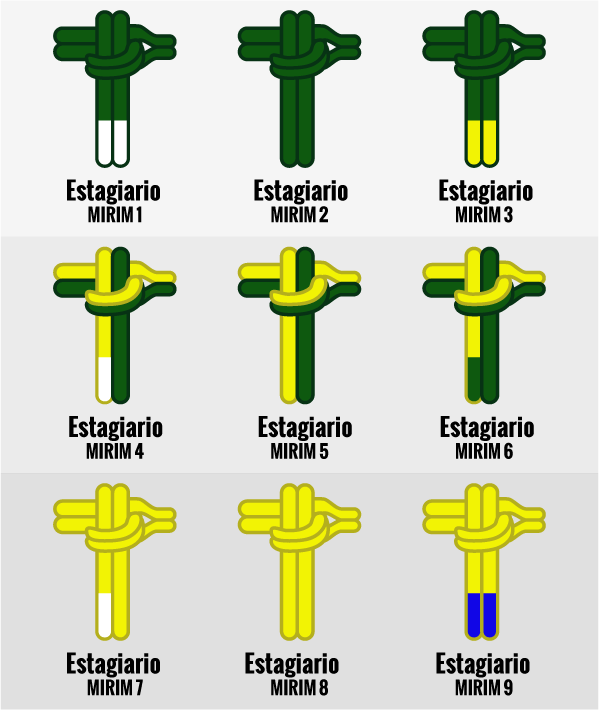


Capoeira teacher, personal trainer.
Group classes, Capoeira shows.
Please contact Samir:
Tel: 079 80 11 26 70